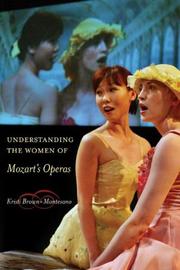| Listing 1 - 1 of 1 |
Sort by
|

ISBN: 052093296X 9780520932968 0520248023 9780520248021 0520248023 9780520248021 Year: 2007 Publisher: Berkeley, Calif. London University of California Press
Abstract | Keywords | Export | Availability | Bookmark
 Loading...
Loading...Choose an application
- Reference Manager
- EndNote
- RefWorks (Direct export to RefWorks)
Is The Marriage of Figaro just about Figaro? Is Don Giovanni's story the only one-or even the most interesting one-in the opera that bears his name? For generations of critics, historians, and directors, it's Mozart's men who have mattered most. Too often, the female characters have been understood from the male protagonist's point of view or simply reduced on stage (and in print) to paper cutouts from the age of the powdered wig and the tightly cinched corset. It's time to give Mozart's women-and Mozart's multi-dimensional portrayals of feminine character-their due. In this lively book, Kristi Brown-Montesano offers a detailed exploration of the female roles in Mozart's four most frequently performed operas, Le nozze di Figaro, Don Giovanni, Così fan tutte, and Die Zauberflöte. Each chapter takes a close look at the music, libretto text, literary sources, and historical factors that give shape to a character, re-evaluating common assumptions and proposing fresh interpretations.Brown-Montesano views each character as the subject of a story, not merely the object of a hero's narrative or the stock figure of convention. From amiable Zerlina, to the awesome Queen of the Night, to calculating Despina, all of Mozart's women have something unique to say. These readings also tackle provocative social, political, and cultural issues, which are used in the operas to define positive and negative images of femininity: revenge, power, seduction, resistance, autonomy, sacrifice, faithfulness, class, maternity, and sisterhood. Keenly aware of the historical gap between the origins of these works and contemporary culture, Brown-Montesano discusses how attitudes about such concepts-past and current-influence our appreciation of these fascinating representations of women.
Operas --- Women in opera. --- Opera --- Opera characters --- Operatic characters --- Characters. --- Characters --- Mozart, Wolfgang Amadeus, --- Mozart, Wolfgang Amadeus --- academia. --- academic studies. --- class in opera. --- cosi fan tutte. --- die zauberflote. --- don giovanni. --- famous opera. --- femininity. --- feminism in classical music. --- feminist studies. --- heros narrative. --- historical gap. --- le nozze di gargo. --- libretto text. --- literary analysis. --- male protagonist. --- marriage of figaro. --- maternity. --- men who wrote women well. --- mozart and women. --- multi-dimensional female characters. --- music appreciation. --- music history. --- political issues within opera. --- provocative social issues. --- sisterhood.
| Listing 1 - 1 of 1 |
Sort by
|

 Search
Search Feedback
Feedback About
About Help
Help News
News